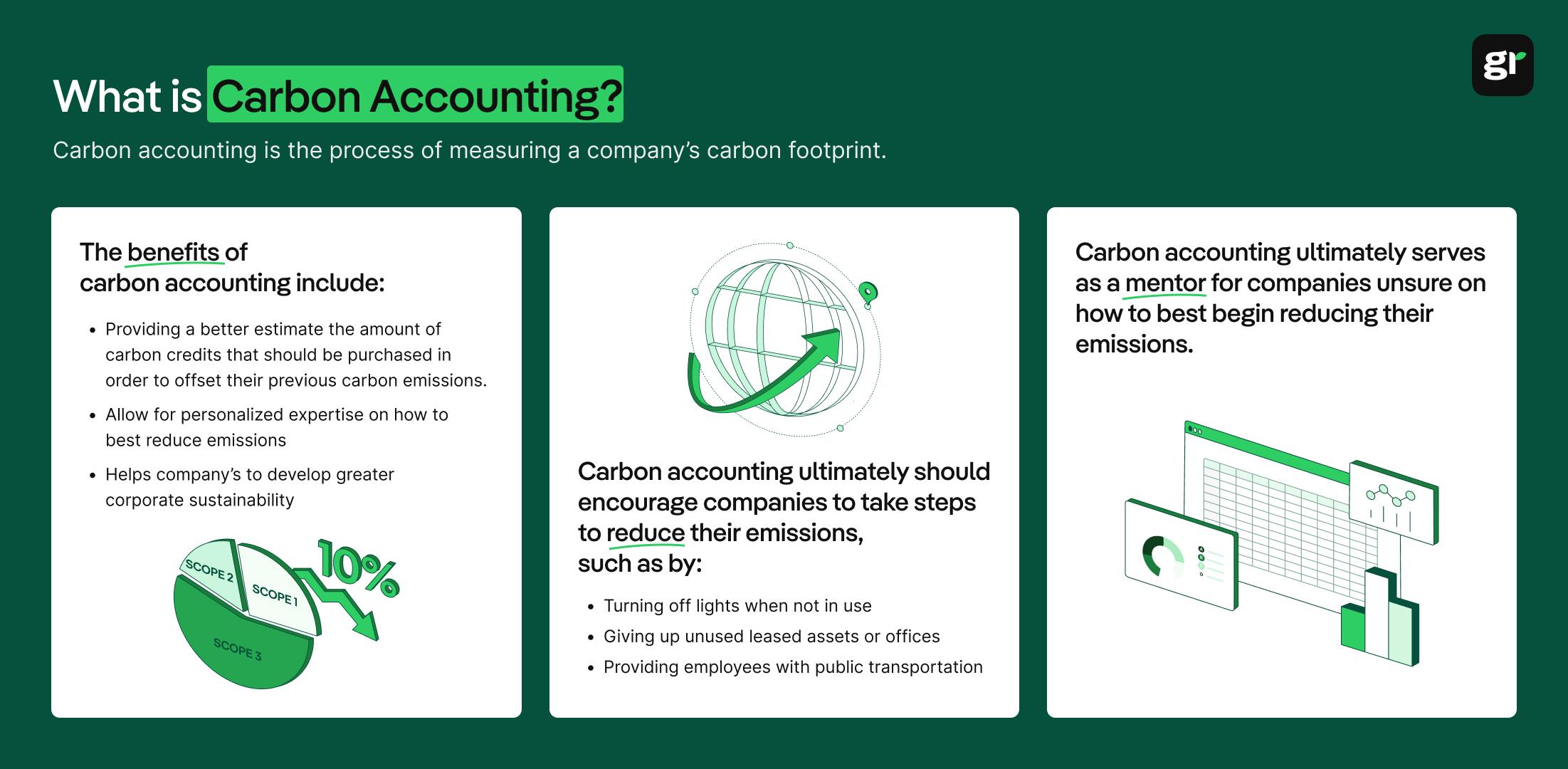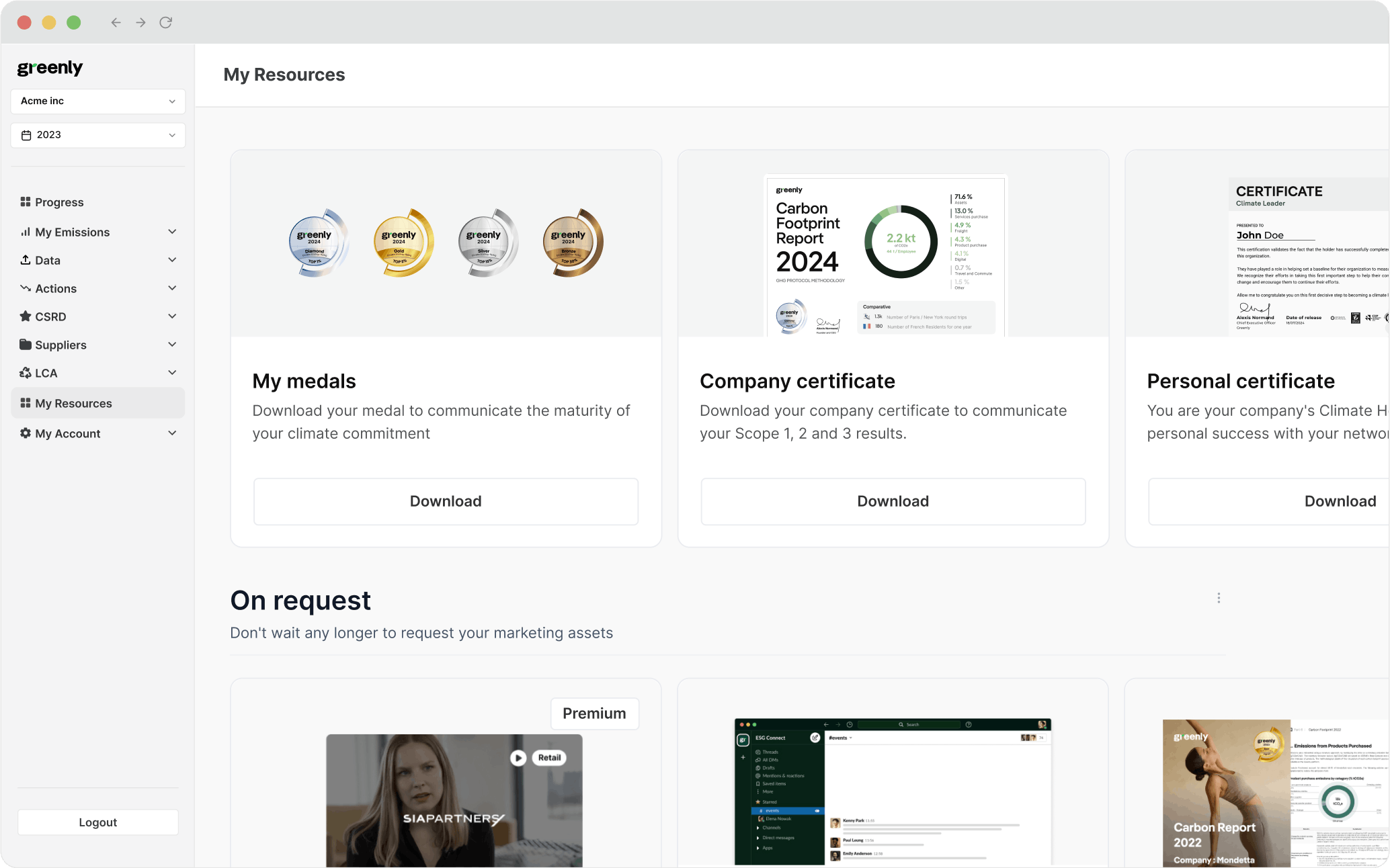
What are the 3 Pillars of Corporate Sustainability?
In this article, we'll explore what the 3 pillars of corporate responsibility are, why they're important, and how businesses can turn them into practical action.
ESG / CSR
Industries



Carbon management is a growing field for addressing the contribution businesses have to climate change and reducing greenhouse gas emissions.
Resources provided by trusted organisations such as the Environmental Protection Agency (EPA) imply that strategic carbon management has become essential for organisations seeking to mitigate their environmental impact while maintaining operational efficiency. The approach is helpful for environmental management, because it applies a practical lens to an often challenging problem of global warming.
In fact, The International Energy Agency (IEA) reported that improvements in energy efficiency made in 2019 avoided an increase of around 200 MtCO₂ in global emissions.
Finding the most straightforward, effective strategies for businesses reducing emissions requires measurement, accuracy, a combination of technological and soft skills, and a commitment to becoming part of the solution to climate change.
This article will explore what carbon management is, evidence-based explanations as to why carbon measuring and reporting is important, and how your organisation can employ effective carbon management strategies.
Carbon management is an organised approach to gain the strategic advantages of CO₂ emissions reductions.
According to the World Resources Institute (WRI), effective carbon management, including systematic measurement and monitoring – can help to avoid and reduce greenhouse gas emissions across an organisation's value chain and business operations.
As a whole, carbon management helps organisations stay focused on achieving their targets to reduce CO₂ emissions and their use of fossil fuels.
The timeline below will reveal how a company utilising carbon management often achieves an improved baseline of carbon emissions or overall sustainability:
Start by measuring your current carbon emissions across Scope 1, 2, and 3 to establish a baseline.
Identify emissions hotspots and understand the key drivers behind your carbon footprint.
Set reduction goals and design a roadmap with targeted decarbonization initiatives.
Take concrete action by reducing emissions through operational changes, supplier engagement, or renewable energy.
Continuously monitor performance, iterate strategies, and improve sustainability outcomes year over year.
With mandatory reporting requirements in the UK and EU, and stakeholder pressure for businesses to set goals to reduce emissions and implement carbon management helps businesses, measure, track, and manage emissions in an organised way.
The Science Based Targets initiative (SBTi) reported at the end of 2023 that over 4,000 companies around the world have committed to emissions reduction targets aligned with climate science, demonstrating the growing desire for businesses to utilise structured carbon management systems.
Carbon management combines practical, cost-effective approaches to reducing annual greenhouse gas (GHG) emissions in ways that enhance environmental performance and create long-term business value. In fact, a study published explains how seeking to employ effective carbon capture processes will allow for reductions in both energy consumption and operational costs.
Carbon management is useful for identifying useful carbon dioxide (CO2) emissions reduction strategies for cutting back the annual emissions business report to stakeholders in their CSR reports. McKinsey & Company has previously shared research illustrating that companies with robust carbon management frameworks are bound to receive better returns on sustainability investments compared to organisations stick to "traditional" financial methods.
The flip cards below (move cursor over card to flip) will reveal how carbon management is beneficial for finance in business:
There are a wide range of strategies employed in carbon management: energy efficiency, low-carbon fuel substitution, renewable energy certificates, life cycle analysis, and the use of new technologies like carbon capture, otherwise known as direct air capture – are all strategies that can help businesses lower their reported CO₂ emissions.
The International Panel on Climate Change (IPCC) has identified these approaches as critical components to the overall global incentive to limit warming to 1.5°C above pre-industrial levels.
However, not all companies can afford carbon capture and storage systems – meaning that some business leaders may need to re-evaluate their industrial processes and use critical thinking to employ effective carbon management strategies.
Unilever demonstrates how process optimisation and supply chain reconfiguration reduced their carbon footprint – such as how they have announced plans to climate fossil fuels in their cleaning products by 2030.
Unilever's "Clean Future" program will include sourcing 100% of the carbon derived from fossil fuels in its cleaning and laundry product formulas with renewable or recycled carbon – in addition to their already existing success in reducing plastic usage by 75% and transportation emissions by 83%.
Additionally, Unilever's Climate Transition Action Plan outlines targets to reduce greenhouse gas emissions across its value chain by 2030, including:
42% reduction in Scope 3 emissions (energy & industrial)
30.3% reduction in Scope 3 emissions (forest, land, and agriculture)
100% reduction in Scope 1 & 2 emissions by 2030 (SBTi-aligned)
Overall, science and research are seeking new ideas for decarbonization technologies are being made all of the time to improve upon sustainable development, but the good news is – emissions reductions can effectively be achieved through the implementation of one or more of these broad categories.
Carbon management does not just look at the problem of carbon emissions added to the atmosphere each year, it supports the development of technologies and approaches to address the legacy emissions and hard to abate industrial emissions.
According to research published in Nature Climate Change, addressing current and previous emissions is crucial to meet our global climate targets. This reveals that even if we completely reduce new generation of CO₂ emissions to zero, carbon management should still support the removal of the build-up of historic CO₂ emissions and usage of fossil fuels.
Within organisations, carbon management goes beyond technology to include policies, training, and techniques that reduce CO2 emissions strategically. With a managerial approach to the problem of CO₂ emissions, organisations can avoid a disorderly and confusing process to alter their systems. A study by the Harvard Business Review explained how companies with comprehensive sustainability strategies often reap the benefits of improved financial performance and risk management.
In other words, technology development can help make a low carbon future a reality. The International Energy Agency's Net Zero by 2050 roadmap outlines how carbon management is an imperative tool to help us achieve global climate objectives.
Luckily, there are multiple pathways of improvement for all organisations regardless of size or sector. In the event of CO₂ emissions reductions, carbon management identifies the pathways of least resistance. For example, Microsoft's carbon negative initiative demonstrate how systematic carbon management helped them to reduce their carbon emissions by from 11.6 million metric tons to 10.9 million metric tons – resulting in a substantial 6% decrease in emissions.

Here are a few evidence-based reasons why carbon management can prove indispensable for businesses:


The table below will depict the importance of carbon management:
| Reason | Description |
|---|---|
| Helps Engage Stakeholders | Effective carbon management demonstrates a company's commitment to environmental sustainability, which can engage and motivate employees, customers, and investors. It shows that the company is proactive in addressing climate change, which can enhance its reputation and stakeholder trust. |
| Attract New Customers and Investors | Many consumers and investors are becoming more environmentally conscious and prefer to support companies that prioritise sustainability. By implementing carbon management practices, businesses can attract a new segment of eco-conscious customers and investors, thereby expanding their market reach and financial opportunities. |
| Avoid Legal Fines from Lack of Compliance | Regulations on carbon emissions are becoming stricter globally. Proper carbon management ensures compliance with these regulations, helping companies avoid legal fines and penalties. Staying ahead of regulatory requirements can also provide a competitive advantage. |
| Long-Term and Sustainable Business Growth | Managing carbon emissions can lead to cost savings through improved energy efficiency and reduced waste. These savings can be reinvested into the business for further growth. Additionally, sustainable practices can open up new business opportunities and markets that are increasingly favoring eco-friendly products and services. |
Climate change will fundamentally shape the course of business over the next few decades, so it is important to stay alert regarding the use of natural gas, GHG emissions, energy costs, and climate change overall.
According to the Task Force on Climate-related Financial Disclosures (TCFD), companies face both transition risks and physical risks from climate change that will impact their financial performance. This is depicted in a 2023 survey conducted by by ZEW (Centre for European Economic Research) indicates that institutional investors place an emphasis on climate risk disclosure, highlighting the importance of sustainability information in investment decisions.
Carbon credentials demonstrate an organisation’s legitimate approach to a globally acknowledged problem: carbon emissions are too high, and science, resources, research, and new ideas need to be sought out for the sake of the climate and reducing harmful greenhouse gases and methane emissions.
Every carbon management system starts with collecting the data on CO₂ emissions, following protocols established by the Greenhouse Gas Protocol, which is recognised by 92% of Fortune 500 companies as the gold standard for emissions accounting. Consider this data a starting point to slice down the numbers towards zero and work towards net reduction.
Furthermore, the Science Based Targets initiative emphasises the importance of setting clear and accurate emissions baselines to effectively reduce greenhouse gas emissions in line with the Paris Agreement goals.

The problem is not just that businesses have not set net zero targets, the issue is many have not even calculated their baseline of GHG emissions. The CO₂ emissions baseline is the starting point which enables carbon management in the first place.
Research published in Nature Climate Change reveals that regardless of increasing regulatory pressure, many companies still struggle to utilise comprehensive carbon accounting, especially for scope 3 emissions which are more difficult to measure and reduce.
However, with a baseline, your organisation can effectively measure progress relative to the starting point. This helps you scope out actions that could immediately minimise your CO₂ footprint and allow for cost savings, or even reduce costs – while also improving efficiency.
The baseline also helps organisations develop strategies with a timeline, budget, and KPIs – like any management problem in an organisation. Your carbon dashboard is a communication tool for benchmarking performance, highlighting progress, and building trust.
The drop down sections will reveal how carbon management can prove beneficial in these areas:
Professor Michael Porter of Harvard Business School has discussed the importance of implementing ESG criteria into business strategies. For example, in research published Mark Kramer, they break down the concept of "shared value," and how businesses could gain long-term value by addressing ESG issues.
“Carbon footprint” is a popular sustainability buzzword, but some people may not fully understand its meaning.
The phrase refers to the sum of greenhouse gases (carbon dioxide, nitrous dioxide, methane, and HFCs) which our carbon intensive activities and other projects produce typically expressed in CO₂-equivalent units (CO₂e) to standardise the global warming potential of different gases, as defined by the Intergovernmental Panel on Climate Change (IPCC).
Carbon footprints can be calculated for individuals, businesses, cities, or even countries. On average, people in the US have a carbon footprint of 16 tons of CO₂ emissions per year. This is much higher than the global annual average of 4 tons. According to research from the Global Carbon Project, this disparity can have a varied impact across different regions – such as with energy consumption patterns, transportation infrastructure, and consumption habits.
Even this average, however, is still too high to limit global emissions to less than 2℃ by 2100. The average global footprint should drop to 2 tons or less per year by 2050. As demonstrated in "Vision 2050" by the World Business Council for Sustainable Development, there are several pathways for businesses to contribute to a more sustainable future – but this can only happen if we excel the push for systematic changes across various sectors.
Businesses have play a central role in helping to reduce the amount of greenhouse gas emissions in the atmosphere, because a large amount of emissions occur during the production and distribution of goods and services, which individuals cannot change.
Here are two evidence-based examples:
You may have seen carbon footprint calculators online which quickly help you audit your lifestyle for its CO₂ emissions impact. However, these calculators only scratch the surface. Greenly supports its clients with a range of services that are useful for carbon measurement and management.
The Greenhouse Gas Protocol, developed by the World Resources Institute and World Business Council for Sustainable Development, provides the most widely used international accounting framework for quantifying corporate emissions.
The vertical timeline below will reveal how companies can calculate the carbon footprint of their company:
Determine which facilities, business units, or assets fall under your footprint calculations.
List all activities and processes that emit greenhouse gases (Scopes 1, 2, and 3).
Gather energy bills, supplier reports, business travel logs, and procurement data.
Apply relevant emissions factors to convert activity data into CO2e equivalents.
Multiply activity data by emissions factors to determine your carbon footprint.
Organise emissions into Scope 1 (direct), Scope 2 (indirect energy), and Scope 3 (indirect value chain).
Disclose findings in line with standards (like GHG Protocol) and identify areas for reduction.
These assess the total level of CO₂ emissions per year for a range of business activities. A carbon footprint measurement converts the activities of your organisation into a tangible set of facts and figures.
According to the International Organization for Standardization (ISO), utilising ISO 14064-1 can allow companies access to a more detailed overview for both direct and indirect emissions sources, providing organisations with a complete inventory that serves as the foundation for strategic carbon management.
These activities may fall within different Scopes. The 3 main Scopes worth addressing include:
Here's a breakdown comparing and contrasting the different scope emissions:
Most emissions fall under scope 3, and reporting recommendations are increasingly concerned with these emissions – as scope 3 can account for a whopping 70% of a company's overall emissions. Assessing the carbon footprint of Scope 3 emissions often benefits from the support of a partnering organisation familiar with the latest measurement techniques.
In fact, research published in Environmental Science & Technology letters explains the now pivotal role of digital monitoring, reporting, and verification technologies (MRV) to help ensure accurate reporting and emissions reductions.
Unlike a carbon footprint, which assesses organisational activities for a given period of time, life cycle analysis looks at how CO2 emissions and other environmental impacts occur across the useful life of a product or service.
The International Organization for Standardization (ISO) has established the ISO 14040 and 14044 standards to govern life cycle assessment methodologies, as both of these standards help to provide a structured framework for corporations to follow worldwide.
Let’s use a product as an example for the emissions created over a product's entire existance:
Therefore, a life cycle analysis produces a flow chart to illustrate how a product is made, transported, used, and eventually disposed. Along each step of the flow chart there are related CO₂ emissions to measure and assess.

Renewable energy sources provide low-carbon opportunities for energy consumption. Renewable energy sources include solar, wind, hydropower, geothermal, power plants, and a range of other opportunities. Most of these energy sources produce no CO₂ emissions once they are operational, proving that power generation doesn't need to create excessive carbon emissions.
When a company reports its energy and fuel mix in a carbon footprint assessment, each type of energy is associated with a different level of CO₂ emissions. By sourcing renewable energy, a business can report zero emissions in this category and improve their carbon management.
So how should a company verify its use of renewable energy? The answer varies depending on which country or region an organisation operates in. Here are a few different opportunities:
Aside from these certificates, companies can also join one of several initiatives to demonstrate their support for expanding renewable energy sources.
The summary cards below will paraphrase the main points of each of these ways to verify the use of renewable energy:
Let U.S. companies support renewable power generation—even when it’s not locally available—by buying credits equal to 1 MWh of clean energy each.
In the UK, REGOs prove that electricity comes from 100% renewable sources—providing traceable, Ofgem-backed certification to businesses.
A global initiative uniting over 400 companies committed to going 100% renewable. As of 2023, 76 companies have already hit the goal.
This UN-backed effort pushes for energy matching in real time—ensuring clean energy is used every hour of every day, not just averaged annually.
The COVID-19 pandemic caused many workplaces to expand their digital and remote working systems out of necessity. Lockdown meant that people couldn't easily travel for conferences or work in shared office spaces.
As a result, a wide range of digital opportunities became more widely used: Zoom, Skype, Slack, and Clubhouse offered networking opportunities both within organisations and externally.
From a carbon footprint perspective, digital working opportunities significantly cut down on the number of work commutes and air miles spent on travel for work purposes. Even after the world opened back up again, most conferences and events still offer reduced-rate entry for digital attendees.
For hard-to-reduce air miles, companies should be aware that every passenger seat type has a different carbon footprint. Areport by Condé Nast Traveler reveals that a round-trip flight from New York to Los Angeles in economy class emits approximately 1,247 pounds of CO₂ per passenger, with the same flight in business class accounting for nearly 25,000 pounds of CO₂.
Employee commutes aren’t the only thing to consider, as studies reveal that companies with fleets of vehicles can reduce their CO₂ emissions by switching to electric vehicles, hybrid, or alternative fuel-source vehicles.
It’s important to think beyond road-based vehicles, too. This includes fleets of lawn mowers, utility vehicles, forklifts, and other equipment used in the operations of a business. Remember, off-road equipment can also account for a significant portion of operational emissions for certain industries such as construction and agriculture.
The driving habits of your employees can also make a considerable difference in terms of the overall CO₂ footprint of a company. To address this, training on low-emissions driving styles, ride sharing incentives, and route optimisation can all improve a company’s transportation-based emissions.
Finally, promoting alternatives to internal combustion engine vehicles such as trains, bikes, and metro all offer carbon management techniques worth exploring – as transportation is repeatedly proven to be one of the main sources of emissions contributing to climate change.

There are literally hundreds of ways businesses can optimise their energy efficiency, and in addition to helping the climate crisis – it can help your company to reduce operational costs and save money. Until you undergo a carbon footprint assessment, these opportunities might not seem obvious.
Retrofits, technology swaps, smart technologies, and operational and behavior changes can all improve energy efficiency metrics. This is why carbon management benefits from innovation and thinking outside the box.
Here are a few ideas to employ energy efficiency:
Heating and cooling contribute significant amounts of CO2 emissions. One of the most impactful green building strategies you can make is switching from a natural gas heater or boiler heater to an energy efficient heat pump.
However, this will require an upfront cost. Researching incentives from your local government may help you finance the shift. The Database of State Incentives for Renewables & Efficiency (DSIRE) at provides an overview of the incentives and policies supporting energy efficiency and renewable energy in the United States.
Operational adjustments can go a long way to cut down on the excess. Smart thermostats can adjust the indoor temperature according to the outside temperature automatically and shift temperature during day and nighttime.
To reduce cooling costs, inventive approaches such as:
Data storage centers often use excess cooling to keep the servers from overheating. However, improving the accuracy of the temperature in the center can cut down on unnecessary cooling costs. This could mean raising or loweing the ambient temperature a few degrees, since the American Society of Heating, Refrigerating and Air-Conditioning Engineers (ASHRAE) recommends temperatures to stay consistent between 15°C to 25°C (59°F to 77°F).
Every item in your office has a life cycle which could prematurely send materials to the landfill. Procurement strategies have proven effective in reducing the amount of unnecessary waste created.
This can include purchasing recycled or used goods, or leasing office furniture. Circular business models that lease equipment and offer repair and maintenance services can extend the useful lifespan of items.
All of the small supplies that are quickly used up in an office such as food, drinks, paper, or other supplies can all be optimised for low-waste alternatives. Composting, food donations, and storing files electronically can all minimise waste from these supplies.
Electronics contribute significant waste each year, so ensuring that your company prioritises recycling e-waste and repair services is another way to minimise waste. The U.S. Environmental Protection Agency estimates that recycling one million laptops saves energy equivalent to the electricity used by more than 3,500 U.S. homes in a year.
Every item that is sent to the landfill adds to your carbon footprint. Remember, The EPA's Waste Reduction Model (WARM) tool allows organisations to determine their greenhouse gas emissions reductions depending on different waste management practices, helping to prioritise waste reduction strategies with the greatest carbon impact.
A: Greenly’s platform stands out for its user-friendly interface, automated data integrations, and robust support for Scope 1, 2, and 3 carbon tracking. Our effective decarbonization strategies in combination with compliance-ready reporting tools make it a top choice for companies of all sizes and sectors.
A: Yes, Greenly is a fully automated carbon footprint software company, designed with the intent to streamline carbon emissions tracking for businesses.
A: Greenly is a better corporate carbon accounting solution as a result of our fair, transparent pricing, full Scope 1, 2, and 3 emissions tracking, and audit-ready reports aligned with major ESG frameworks. We also offer end-to-end project management, guide businesses through data collection, personalized reduction strategies, and regulatory compliance in one streamlined platform.
A: Greenly is a good choice for companies seeking to measure the more difficult Scope 3 emissions thanks to our precise calculations using both the spend-based and activity-based methods, in addition to our automated data collection.
Greenly helps businesses conduct carbon footprint assessments and develop carbon management strategies to draw down emissions.
Click here to learn more about Greenly and how we can help you reduce your carbon footprint.
Don't wait any longer, take the first step towards reducing your carbon footprint by requesting a free and non-binding demo with one of our experts today and finding the solution that best fits your business needs.
